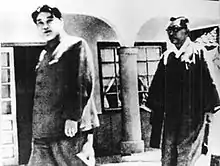 The North Korea Portal The North Korea PortalIntroductionNorth Korea, officially the Democratic People's Republic of Korea (DPRK), is a country in East Asia. It constitutes the northern half of the Korean Peninsula and borders China and Russia to the north at the Yalu (Amnok) and Tumen rivers, and South Korea to the south at the Korean Demilitarized Zone. North Korea's border with South Korea is a disputed border as both countries claim the entirety of the Korean Peninsula. The country's western border is formed by the Yellow Sea, while its eastern border is defined by the Sea of Japan. North Korea, like its southern counterpart, claims to be the legitimate government of the entire peninsula and adjacent islands. Pyongyang is the capital and largest city. The history of present-day Korea began with the foundation of Gojoseon in 2333 BC by the mythic king Dangun, but no archaeological evidence and writing was found from this period. Following the unification of the Three Kingdoms of Korea under Unified Silla in 668 AD, Korea was subsequently ruled by the Goryeo dynasty (918–1392) and the Joseon dynasty (1392–1897). In 1897, King Gojong proclaimed the Korean Empire, which was annexed by the Empire of Japan in 1910. In 1945, after the Japanese surrender at the end of World War II, Korea was divided into two zones along the 38th parallel, with the north occupied by the Soviet Union and the south occupied by the United States. In 1948, separate governments were formed in Korea: the socialist and Soviet-aligned Democratic People's Republic of Korea in the north, and the capitalist, Western-aligned Republic of Korea in the south. The Korean War began when North Korean forces invaded South Korea in 1950. In 1953, the Korean Armistice Agreement brought about a ceasefire and established a demilitarized zone (DMZ), but no formal peace treaty has ever been signed. Post-war North Korea benefited greatly from economic aid and expertise provided by other Eastern Bloc countries. However, Kim Il Sung, North Korea's first leader, later purged both pro-Soviet and pro-Chinese elements from the ruling Workers' Party of Korea and promoted his personal philosophy of Juche as the state ideology. Pyongyang's international isolation sharply accelerated from the 1980s onwards as the Cold War came to an end. The fall of the Soviet Union in 1991 then brought about a sharp decline to the North Korean economy. From 1994 to 1998, North Korea suffered a famine that resulted in the deaths of between 240,000 and 420,000 people, and the population continues to suffer from malnutrition. North Korea is a totalitarian dictatorship with a comprehensive cult of personality around the Kim family. The country is widely considered to have the worst human rights record in the world. Officially, North Korea is an "independent socialist state" which holds democratic elections; however, outside observers have described the elections as sham elections. The Workers' Party of Korea is the ruling party of North Korea and leads the Democratic Front for the Reunification of Korea, the sole legal political movement in the country. According to Article 3 of the constitution, Kimilsungism–Kimjongilism is the official ideology of North Korea. The means of production are owned by the state through state-run enterprises and collectivized farms. Most services—such as healthcare, education, housing, and food production—are subsidized or state-funded. (Full article...) Selected article -The Hill 303 massacre (Korean: 303 고지 학살 사건) was a war crime that took place during the opening days of the Korean War on August 17, 1950, on a hill above Waegwan, Republic of Korea. Forty-one United States Army (US) prisoners of war were murdered by troops of the North Korean People's Army (KPA) during one of the engagements of the Battle of Pusan Perimeter. Operating near Taegu during the Battle of Taegu, elements of the US 2nd Battalion, 5th Cavalry Regiment, 1st Cavalry Division, were surrounded by KPA troops crossing the Nakdong River at Hill 303. Most of the US troops were able to escape, but one platoon of mortar operators misidentified KPA troops as Republic of Korea Army (ROK) reinforcements and was captured. KPA troops held the Americans on the hill and initially tried to move them across the river and out of the battle, but they were unable to do so because of a heavy counterattack. US forces eventually broke the KPA advance, routing the force. As the KPA began to retreat, one of their officers ordered the prisoners to be shot so they would not slow them down. The massacre provoked a response from both sides in the conflict. US commanders broadcast radio messages and dropped leaflets demanding the senior North Korean commanders be held responsible for the atrocity. The KPA commanders, concerned about the way their soldiers were treating prisoners of war, laid out stricter guidelines for handling enemy captives. Memorials were later constructed on Hill 303 by troops at nearby Camp Carroll to honor the victims of the massacre. (Full article...)CategoriesCategory puzzle Select [►] to view subcategories
North Korea North Korea-related lists Buildings and structures in North Korea North Korean culture Economy of North Korea Education in North Korea Environment of North Korea Foreign charities operating in North Korea Geography of North Korea Government of North Korea Health in North Korea History of North Korea North Korean studies Organizations based in North Korea North Korean people Politics of North Korea Society of North Korea North Korea stubs Related portalsCommunist countries in Asia Other countries North Korea in the news
Selected image -.jpg.webp)
Buddhist monk at Habiro Hermitage in Hyangsan, North Pyongan
Did you know (auto-generated)
More did you know
General images -The following are images from various North Korea-related articles on Wikipedia.
North Korea topicsThings you can do
Associated WikimediaThe following Wikimedia Foundation sister projects provide more on this subject:
Web resources
Notes Discover Wikipedia using portals
|






















